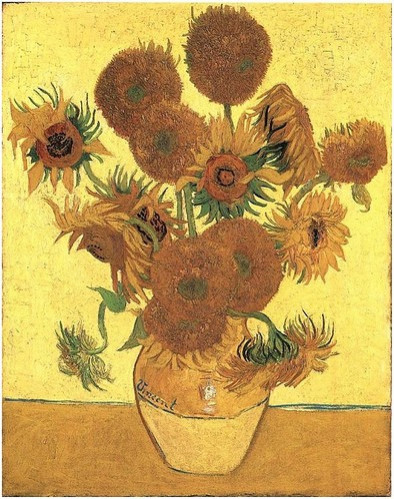Van Gogh Sunflowers: Genetic Portrait Painted By Scientists

If you look closely at Vincent Van Gogh's sunflower paintings, a flower sometimes seems slightly out of place. In the midst of flowers with dark centers surrounded by rings of yellow rays, a few have puffball-like faces that sport multiple bands of yellow.
The so-called double-flowered sunflower is a relatively common ornamental type, says University of Georgia biologist John M. Burke, the senior author of a study that unlocks the genetic secrets of these variants published Thursday in the journal PLoS Genetics.
Sunflower breeders can create dandelion-like sunflowers like those depicted in Van Gogh's paintings, but researchers didn't understand the genetics behind this frilly variant.
A sunflower head is not a single flower, but a collection of two kinds of small flowers called florets: flattened ray florets form the petal-like outer ring and hundreds of tubular disc florets arranged in whorls form the middle.
Burke and his team found that in double-flowered mutants, tubular florets are switched to flattened florets because of a mutation that inserts an extra bit of DNA in HaCYC2c, one of the genes that determines what kind of floret the sunflower makes. The mutation switches on HaCYC2c in disc florets, causing them to develop into petal-like structures.
HaCYC2c resembles the CYCLOIDEA gene originally identified in 1996 in snapdragon flowers. Cycloidea-like genes are also known to play a role in the shapes of floral structures in the Gerber daisy and other members of the daisy family.
Sunflowers with both copies of the mutated gene were fully double-flowered while plants with only one copy of the mutation were not as severely mutated, but were less fertile than the non-mutated flowers, according to the study.
Heads and individual florets from normal (A and B), double-flowered (C and D) and tubular (E and F) sunflowers. Credit: PLoS Genetics/Chapman et al.
The UGA scientists also discovered another mutation that resulted in a mirror-image of the double-flowered plants, where the petal-like florets grew in tube-like formations. In these mutants the ray florets, normally sterile, also regained some reproductive structures, Burke says.
Many other denizens of the florist's shop, such as roses and carnations, are carefully cultivated double-flowered mutants. But these flowers are structurally different than the double-flowered sunflower; they attain their layered shape by replacing some of their sexual organs with petals.
Burke is also interested in discovering the gene or genes behind another aspect of sunflower morphology. Whereas the garden-variety sunflower is one tall stalk topped by a large head, wild sunflowers are bushier, branching off and terminating in multiple flowers on the same plant.
This loss of branching is a common thing that happened during the domestication of other plants, such as corn, Burke says.
© Copyright IBTimes 2025. All rights reserved.





















